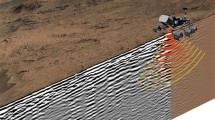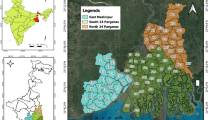Abstract
This paper deals with the application of the Ground Penetrating Radar (GPR) method in the assessment of stone monuments. Compilation of published works and a discussion of their main findings are first addressed. Next, to show the potential of the method, a case study is presented aiming to assess the state of conservation of the rock necropolis of San Vítor de Barxacova (Ourense, Spain) consisting of 56 anthropomorphic graves carved into the natural rock. Fieldwork was carried out using a GPR system equipped with a 2.3 GHz central frequency antenna. The main goal of this study is to provide an effective approach for the detection and localization of internal damages such as fractures and voids. New amplitude-based 2D and 3D imaging strategies are presented aiming to improve damage detection. A new approach was also developed to digitize the extracted information into a point cloud format, thus improving the possibilities for 3D visualization with the surrounding environment. Although a total of 39 graves were surveyed, only 13 graves are included in this paper due to their singularity and relevant results. The potential of using GPR tests for the assessment of the conservation state of monumental stone structures is also discussed.
Article Highlights
-
A case study is presented aiming to assess the state of conservation of a rock necropolis (cemetery) in Spain
-
New amplitude-based imaging strategies allowed us to detect inner voids and fractures
-
A new approach was developed to digitize the extracted information into a point cloud format










Similar content being viewed by others
References
Annan P (2003) GPR principles, procedures and applications. Sensors and Software Inc., Mississauga, p 278
Barone PM, Di Matteo A, Graziano F, Mattei E, Pettinelli E (2010) GPR application to the structural control of historical buildings: two case studies in Rome, Italy. Near Surf Geophys 8:407–413
Binda L, Saisi A, Tiraboschi C, Valle S, Colla C, Forde M (2003) Application of sonic and radar tests on the piers and walls of the Cathedral of Noto. Constr Build Mater 17:613–627
Buceta G, Carrera F (2013) Memorias: porpostas de conservación-restauración das tumbas da necrópole de San Vítor de Barxacova (Parada de Sil, Ourense) [in Galician]. Dirección Xeral de Patrimonio Cultural, Xunta de Galicia
Catapano I, Ludeno G, Soldovieri F, Tosti F, Padeletti G (2018) Structural assessment via ground penetrating radar at the consoli Palace of Gubbio (Italy). Remote Sens 10:45
Conde B, Ramos LF, Oliveira DV, Riveiro B, Solla M (2017) Structural assessment of masonry arch bridges by combination of non-destructive testing techniques and three-dimensional numerical modelling: Application to Vilanova bridge. Eng Struct 148:621–638
Conyers LB (2004) Ground-penetrating radar for archaeology. Geophysical methods for archaeology. Altamira Press, Lanham
De Rosario I, Rivas T, Buceta G, Feijoo J, Mosquera MJ (2017) Surfactant-synthesized consolidants applied to a granite medieval necropolis in NW Spain. Laboratory and in situ effectiveness evaluation. Int J Archit Heritage 11(8):1166–1176
Dimitriadis K (2015) GPR in the preservation of cultural heritage. In: Proceedings of third general meeting, COST action TU1208, London, UK, March. Aracne, Ariccia. Book series: COST Action TU1208, Rome, Italy
Giunta G, Calloni G (2020) Ground penetrating radar applications on the façade of St. Peter’s Basilica in Vatican. In: 15th WNDT, Rome
Goodman D, Piro S (2013) GPR remote sensing in archaeology, geotechnologies and the environment, vol 9. Springer, Berlin
Grasmueck M, Weger R, Horstmeyer H (2005) Full-resolution 3D GPR imaging. Geophysics 70(1):K12–K19
Grinsted A (2022) RD3 Library. MATLAB central file exchange. https://www.mathworks.com/matlabcentral/fileexchange/6129-rd3-library. Retrieved Jan 27, 2022
ICOMOS-ISCS (2008) Illustrated glossary on stone deterioration patterns. Monuments and sites XV, Ateliers 30 Impression, Champigny/Marne, France
Kadioglu S (2013) Tansparent 2d/3d half bird’s-eye view of ground penetrating radar data set in archaeology and cultural heritage. Chapter 5 in: Imaging and radioanalytical techniques in interdisciplinary research—fundamentals and cutting edge applications
Kadioglu S, Kadioglu KY, Akyol AA (2015) Picturing monuments and cultural heri-tages with ground penetrating radar method including its half bird’ s eye view visualiza-tion. In: Proceedings of the 8th international workshop on advanced ground penetrating radar (IWAGPR), 7–10 July, Florence, Italy: 1–4
Leucci G, Cataldo R, De Nunzio G (2007) Assessment of fractures in some columns inside the crypt of the Cattedrale di Otranto using integrated geophysical methods. J Archaeol Sci 34(2):222–232
Leucci G, Masini N, Persico R, Soldovieri F (2011) GPR and Sonic tomography for structural restoration: the case of the cathedral of Tricarico. J Geophys Eng 8(3):76–92
Masini N, Nuzzo L, Rizzo E (2007) GPR investigations for the study and restoration of the rose window of Troia Cathedral (southern Italy). Near Surf Geophys 5(5):287–300
Masini N, Persico R, Rizzo E, Calia A, Giannotta MT, Quarta G, Pagliuca A (2010) Integrated techniques for analysis and monitoring of historical monuments: the case of San Giovanni al Sepolcro in Brindisi (Southern Italy). Near Surf Geophys 8(5):423–432
MathWorks (2022) Find outliers in data—MATLAB isoutlier. https://es.mathworks.com/help/matlab/ref/isoutlier.html. Retrieved Feb 21, 2022
Nuzzo L, Calia A, Liberatore D, Masini N, Rizzo E (2010) Integration of ground-penetrating radar, ultrasonic tests and infrared thermography for the analysis of a precious medieval rose window. Adv Geosci 24:69–82
Ortega-Ramírez J, Bano M, Larrea-López L, Robles-Camacho J, Ávila-Luna P, Villa- Alvarado LA (2019) GPR measurements to identify cracks and textural arrangements in the altar wall of the 16th century Santa Maria Huiramangaro Church, Michoacán, Mexico. Near Surf Geophys 17(3):247–261
Pérez-Gracia V, Caselles JO, Clapés J, Martinez G, Osorio R (2013) Non-destructive analysis in cultural heritage buildings: evaluating the Mallorca cathedral supporting structures. Non Destruct Test Evaluat Int 59:40–47
Ranalli D, Scozzafava M, Tallini M (2004) Ground penetrating radar investigations for the restoration of historic buildings: the case study of the Collemaggio Basilica (L’Aquila, Italy). J Cult Herit 5:91–99
Sánchez-Biezma MJ (2021) Estudos transversais na necrópole rupestre de San Vitor de Barxacova GA32057004 [in Galician]. Dirección Xeral de Patrimonio Cultural, Xunta de Galicia
Sandmeier K (2022) ReflexW. Manual version http://www.sandmeier-geo.de. Accessed Jan 2022
Santos-Assunçao S, Dimitriadis K, Konstantakis Y, Perez-Gracia V, Anagnostopoulou E, Gonzalez-Drigo R (2016) Ground-penetrating radar evaluation of the ancient Mycenaean monument Tholos Acharnon tomb. Near Surf Geophys 14(2):197–205
Soldovieri F, Masini N, Persico R, Catapano I (2017) GPR diagnostics of columns in archaeological contexts. In: Geophysical Research Abstracts, vol 19, EGU General Assembly
Solla M, Lorenzo H, Riveiro B, Rial FI (2011) Non-destructive methodologies in the assessment of the masonry arch bridge of Traba, Spain. Eng Fail Anal 18:828–835
Solla M, González-Jorge H, Álvarez MX, Arias P (2012) Application of non-destructive geomatic techniques and FDTD modeling to metrical analysis of stone blocks in a masonry wall. Constr Build Mater 36:14–19
Solla M, Riveiro B, Lorenzo H, Armesto J (2014) Ancient stone bridge surveying by ground-penetrating radar and numerical modeling methods. J Bridg Eng 19(1):110–119
Solla M, Gonçalves LMS, Gonçalves G, Francisco C, Puente I, Providência P, Gaspar F, Rodrigues H (2021) A building information modeling approach to integrate geomatic data for the documentation and preservation of cultural heritage. Remote Sens 12:4028
Zuñiga D (2018) Caracterización geotécnica del macizo de la necrópolis de San Vítor de Barxacova. Implicaciones en su conservación [in Spanish]. Universidade de Vigo
Acknowledgments
This work has received funding from the Xunta de Galicia—GAIN—through the project ENDITí (Ref. ED431F 2021/08). M. Solla acknowledges the Grant RYC2019–026604–I funded by MCIN/AEI/10. 13039/501100011033 and by “ESF Investing in your future.” Funding for open access charge: Universidade de Vigo/CISUG. The algorithms developed for the recognition of fracture patterns in granite and digitization into a point cloud are a contribution to the project Ref. RTI2018-095893-B-C21. This article is based upon work from COST Action SAGA: The Soil Science and Archeo-Geophysics Alliance—CA17131 (www.saga-cost.eu), supported by COST (European Cooperation in Science and Technology www.cost.eu).
Author information
Authors and Affiliations
Corresponding author
Additional information
Publisher's Note
Springer Nature remains neutral with regard to jurisdictional claims in published maps and institutional affiliations.
Rights and permissions
About this article
Cite this article
Solla, M., Buceta-Bruneti, G., Elseicy, A. et al. Ground Penetrating Radar Applied to Monumental Stone Conservation: Application to the Rock Necropolis of San Vítor de Barxacova in NW Spain. Surv Geophys 43, 1587–1606 (2022). https://doi.org/10.1007/s10712-022-09728-x
Received:
Accepted:
Published:
Issue Date:
DOI: https://doi.org/10.1007/s10712-022-09728-x




